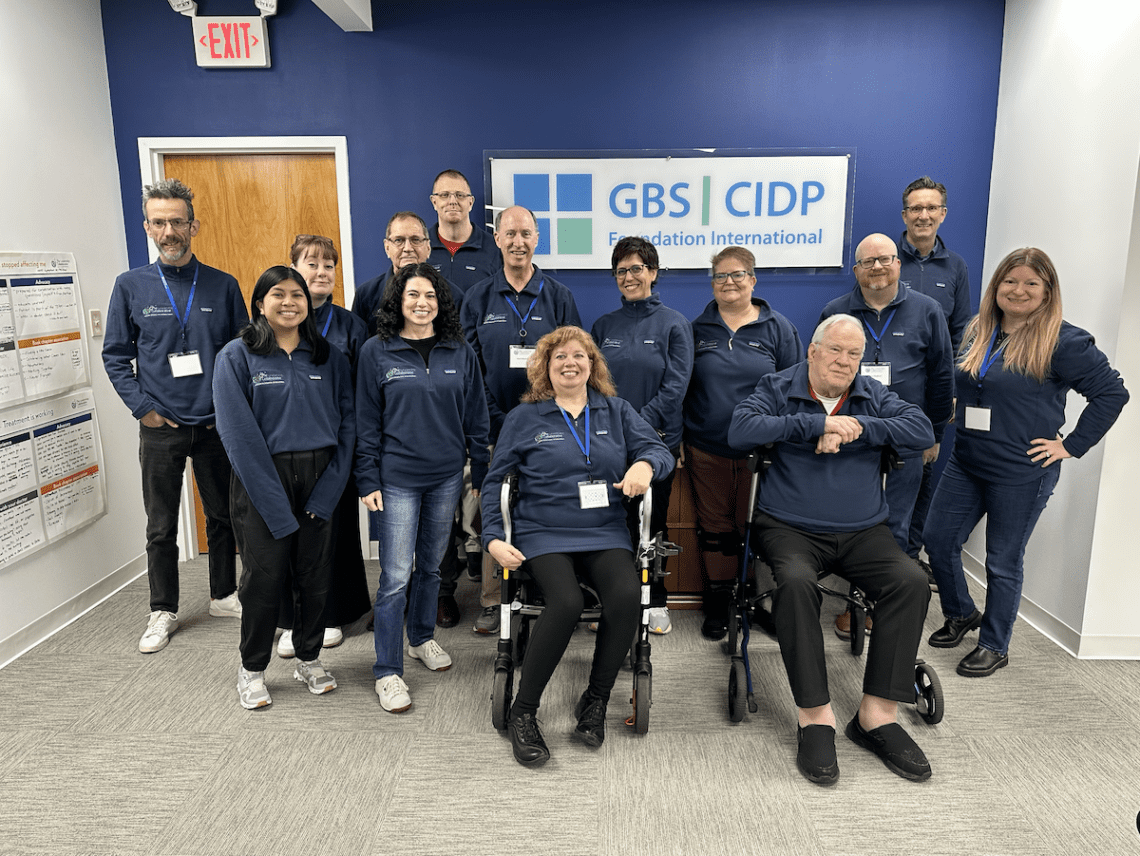
GBS|CIDP Leadership Collaborative Workshop
Aims:
- To reach a consensus on the definition of four terms related to the clinical care of CIDP: Treatment Response (partial and complete), Refractory, Relapse, and Remission
- To reach a consensus on how to employ these definitions across patient care and clinical research
- To develop a strategy for broad acceptance of these definitions from all relevant stakeholders
Deliverables:
- A drafted definition for each term at the conclusion of the meeting.
- A whitepaper describing the process by which consensus was reached and defining the terms to be published within 6 months after the meeting.
- A patient journey map to help patients better understand their anticipated course of CIDP disease to be created within 6 months after the meeting.
Patient Workshop Summary
Required Pre-Reading:
- GBS|CIDP Foundation Leadership Collaborative US Patient Community Workshop Clinical Terms Executive Summary – Click Here To View
Other Pre-Reading:
- Community Workshop Summary PPT – Click Here To View
- Care Partner Virtual Workshop Summary PPT – Click Here To View
Definitions
Definitions: Download here.
Immune Neuropathy – Evidence of Disease Activity (IN-EDA) and No Evidence of Disease Activity (IN-NEDA)
IN-EDA: Patient perception of change* AND a change in disability**, impairment***, or both. There must be no other condition that better explains change in disability and impairment
IN-NEDA 1: No patient perception of change* AND either no decline in Disability** OR no decline in Impairment*** for a duration of 6 months or more
IN-NEDA 2: No patient perception of change* AND no decline in Disability** AND no decline in Impairment*** components for a duration of 6 months or more.
* Patient Global Impression of Change (PGIC)
** Disability: Defined as a I-RODS 4-point (centile) change or INCAT 1-point change
***Impairment: Defined as a grip strength 8 kPa or 10% averaged change or MRC 60 sum score 2 point change
Recommendation for clinical practice and clinical trials: Qualify IN-EDA or IN-NEDA status as “on treatment” or “off treatment”
Recommendation for clinical trials: target NEDA-2 status
Response, Minimal – Patient perception of improvement AND a minimum change [as defined in the IN-EDA definition] on at least one outcome measure suggesting at least early partial response to a specific treatment, assessed within 12 weeks.
Response, Partial – Patient perception of improvement AND a change on at least one outcome measure that reaches a higher change threshold (compared to minimal response) within 24 weeks. To meet the definition of partial response a change of I-RODS of 8 centile points (or reaching maximum I-RODS), MRC sum score of 4 points (or reaching maximum MRC sum score) or grip strength of 14 kPa is needed. A change in INCAT remains at 1 or more points.
Response, Optimal – Recovery as close as possible to the pre-CIDP functional status excluding potential residuals, and fulfilling IN-NEDA 2 criteria sustained for at least 6 months.
Relapse: Patient perception of change AND decline in disability AND impairment fulfilling IN-EDA definition following a period of stability or improvement, without a condition that better explains change in function and impairment, over a period of 12 weeks or less
Refractory: Absence of minimal response OR relapse leading to/requiring treatment discontinuation after adequate dosing and duration of the administered therapy.
Remission: No signs of disease activity (IN-NEDA 2) with or without residuals without immunosuppressive/immunomodulatory therapy for at least 12 months.
Residuals: Signs, symptoms, or impairments related to CIDP that persist despite adequate immunosuppressive/immunomodulatory therapies and are present in a patient who otherwise has no evidence of disease activity (IN-NEDA).
Simplified Definitions
Terms Defined in Common Language:
The definitions below are simplified to help patients explain their current CIDP status to their loved ones, friends, and neighbors. These simplified definitions do not replace the important official definitions used by healthcare professionals. Instead, they supplement and provide an easier way to talk about CIDP to non-healthcare professionals.
IN-EDA (Inflammatory Neuropathy-Evidence of Disease Activity)
This means that it is likely that your immune system is actively injuring your nerves.
You feel that your neuropathy is worse, and there is a measurable negative change in strength, function, or both.
You and your doctors should also make sure there isn’t another reason for the change.
IN-NEDA (Inflammatory Neuropathy- No Evidence of Disease Activity)
This means that it is likely that your immune system is not active and not causing new injuries to your nerves. There are two levels:
- IN-NEDA
You do not feel your neuropathy symptoms worsening and for at least 6 months, you either:- Haven’t gotten worse in your daily function as measured by your doctor, OR
- Haven’t gotten worse in your strength as measured by your doctor.
- IN-NEDA 2:
You do not feel your neuropathy symptoms worsening and for at least 6 months, you:- Haven’t gotten worse in your daily function as measured by your doctor, AND
- Haven’t gotten worse in your strength as measured by your doctor.
(This is the goal for clinical trials.)
Response, Minimal:
You feel that your neuropathy is a little better and there is a small improvement in strength or function as measured by your doctor. This happens within 3 months of starting treatment.
Response, Partial:
You feel your neuropathy is better and show a bigger improvement in at least one test of strength or function as measured by your doctor. This happens within 6 months.
Response, Optimal:
Your neuropathy has improved a lot—almost back to how you were before your symptoms initially began. You also meet IN-NEDA 2 criteria and stay that way for at least 6 months.
Relapse:
After getting better or stable, your neuropathy symptoms come back. You feel worse and tests of function and strength from your doctor have gone down. This happens over 12 weeks or less.
Refractory:
The treatment doesn’t work at all—or it stops working and has to be stopped—despite giving it a full try.
Remission:
Your neuropathy is quiet. You meet IN-NEDA 2 criteria (no signs of disease), and you’ve been off all immune treatments for at least 12 months. You may still have some residuals.
Residuals:
These are leftover symptoms or problems with strength or function that stay even when the disease is no longer active. Residuals are due to old nerve injuries that are not expected to improve with immune drugs. Supportive interventions, like physical therapy, may be helpful.
10 words or fewer:
IN-EDA:
You feel symptoms and tests show strength or function decline.
IN-NEDA 1:
You do not feel worse; no worsening in strength or function.
IN-NEDA 2:
You do not feel worse; no worsening in strength and function.
Minimal Response:
You feel a bit better with small test improvements.
Partial Response:
You feel better with bigger test improvements.
Optimal Response:
Improved as much as possible (some residuals may persist) ; no disease signs for 6 months.
Relapse:
Symptoms return, and tests show you’re getting worse.
Refractory:
Treatment doesn’t help or must be stopped.
Remission:
No disease signs for 12+ months without treatment.
Residuals:
Ongoing symptoms even without active disease.
A Look Back on the Weekend of Collaboration!







